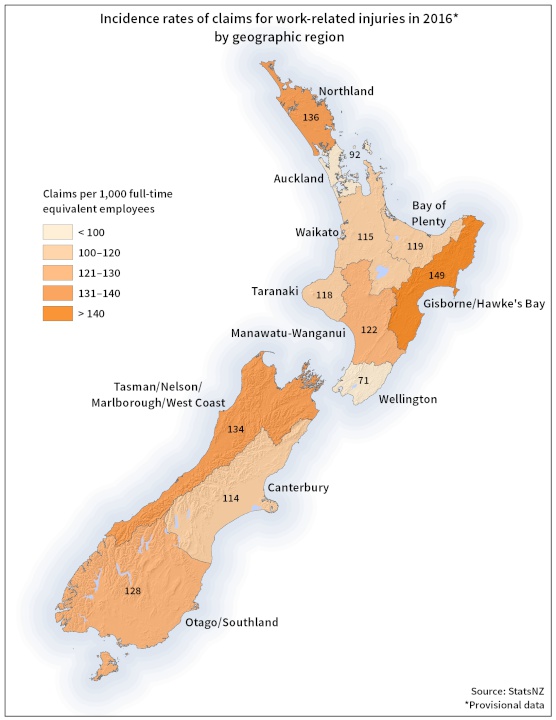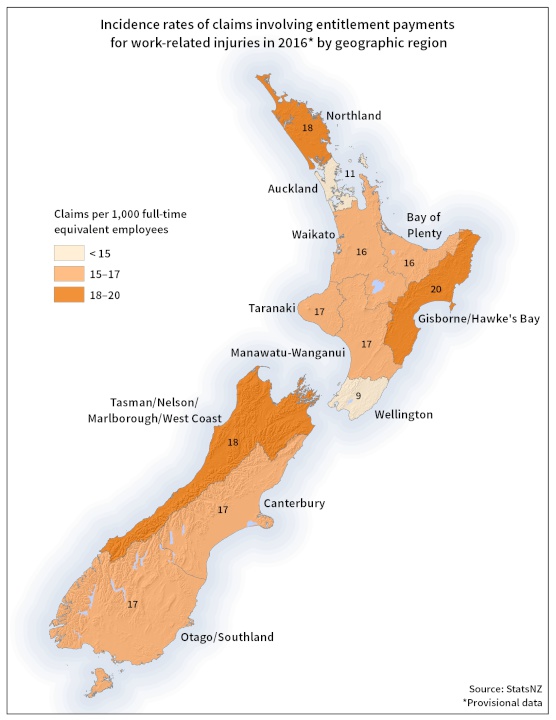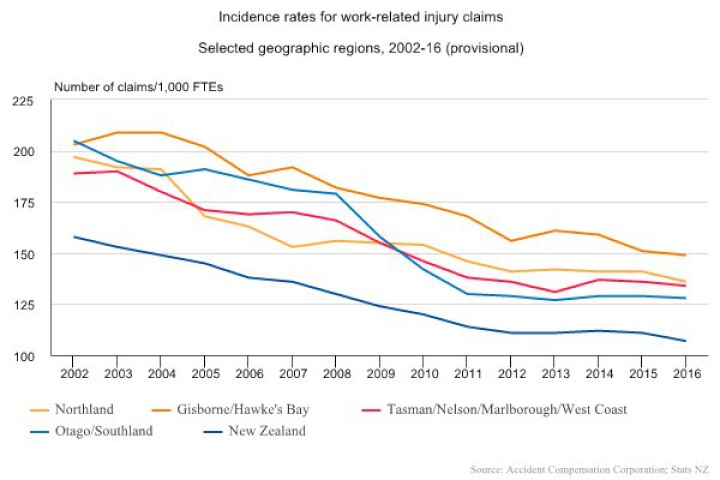East coast workers top injury rates
East coast workers top injury rates
31 August 2017 - Gisborne/Hawke’s Bay region workers had the highest work-related injury rate in 2016, Stats NZ said today.
The Gisborne/Hawke’s Bay region had 149 work-related injury claims per 1,000 full-time equivalent employees (FTEs) in 2016. This could be due to the high proportion of this region’s workers being in the agriculture, forestry, and fishing industry, which had the second-highest injury rate of all industries.
Claims from workers in Gisborne/Hawke’s Bay accounted for 6 percent of all claims.
The lowest incidence rate in 2016 was in the Wellington region, with 71 claims per 1,000 FTEs. This is likely to be because this region has a large proportion of workers in the three industries with the lowest injury rates. Workers in Wellington, the third-largest region by FTEs, accounted for 8 percent of all claims.
The incidence rate for all New Zealand was 107 claims per 1,000 FTEs in 2016. These provisional figures are based on work-related injury claims accepted by the Accident Compensation Corporation.

The incidence rate for more serious work injuries in New Zealand was 14 entitlement claims per 1,000 FTEs in 2016. These types of claims could include additional payments such as death benefits, loss of earning payments, lump sums, and rehabilitation payments.
“Across the regions, the rates for more serious injury claims showed a similar pattern as for total claims, with the highest rate for entitlement claims also in Gisborne/Hawke’s Bay and the lowest in Wellington,” government injury information manager Dan Oberhaus said.

Trend decreases over time
Incidence rates have decreased in all regions since 2002. However, the decrease has slowed since 2012, and in recent years some regions have shown slight increases. The four regions with the highest incidence rates in 2016 show the overall declining trend. Since 2010, these four regions’ rankings have stayed the same.
Note: because FTE figures are from the Household Labour Force Survey, the survey’s recent redevelopment may affect rate changes between 2015 and 2016.

Geographic regions are groupings of territorial authorities.
ENDS


 Business Canterbury: Urges Council To Cut Costs, Not Ambition For City
Business Canterbury: Urges Council To Cut Costs, Not Ambition For City Wellington Airport: On Track For Net Zero Emissions By 2028
Wellington Airport: On Track For Net Zero Emissions By 2028 Landcare Research: ANZAC Gall Fly Release Promises Natural Solution To Weed Threat
Landcare Research: ANZAC Gall Fly Release Promises Natural Solution To Weed Threat NZ Anti-Vivisection Society: Auckland Rat Lovers Unite!
NZ Anti-Vivisection Society: Auckland Rat Lovers Unite! University of Canterbury: $1.35 Million Grant To Study Lion-like Jumping Spiders
University of Canterbury: $1.35 Million Grant To Study Lion-like Jumping Spiders Federated Farmers: Government Ends War On Farming
Federated Farmers: Government Ends War On Farming



